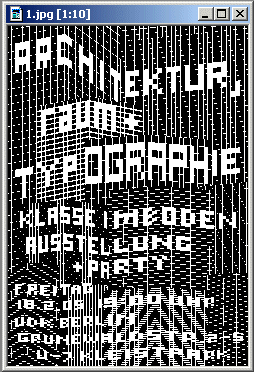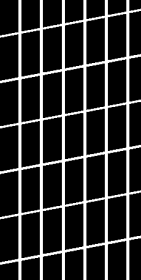



| More and more often I am getting posters that are impossible to show on Poster Page, see for example Philippe Apeloig 1, Philippe Apeloig 2, Leonardo Sonnoli, Mehdi Saeedi, Bi Xuefeng. Below are screen shots of another example, a poster made by Ole Haentzschel, a student of Melk Imboden at the University of the Arts (UdK) in Berlin, seen in different magnification on my monitor: |
 |
 |
 |
 |
|
To show that these are quite different pictures, and not just smaller versions of the same poster, I have
scaled two of them back to the same size for easier comparison. The lower part of the poster in particular changes in unpredictable ways.
In the digital photo of the poster, the mushy black and white background is not due to bad printing or bad weather, the lines are perfectly clear and evenly spaced in the original. |
 |
 |
 |
 |
|
The reason for all this chaos is explained by Shannon's
sampling theorem, a basic law of information theory. Roughly translated into plain english, it says
that you can not paint a life size picture of a mouse with an elephant size brush, and conversly that you do
not need a mouse size brush to paint a life size picture of an elephant.
Applied to Ole's poster as seen on Rene's monitor, it is a matter of hit and miss whether his lines just fall on a pixel of my display or not. Let's look at the numbers: My monitor is about 36 cm wide and has a horizontal resolution of 1024 pixels (as most of the readers of Poster Page have, see the table below, taken from my visitor statistics program): |
| |||||||||||||||||||||||||||||||||||||||||
|
One pixel on our monitors therefore has a size of (36 cm / 1024) = 350 microns (= 0.35 mm). If a poster of 100 cm height
is shown as a 10 cm picture, this means that a line with a diameter of 3.5 mm on the poster is just one pixel wide on the
screen, not enough according to Shannon's theorem, which says you need at least twice the resolution to show it
properly. No amount of sharpening software or contrast enhancement will get you around this theoretical limit.
Objects smaller than about 7 mm are just impossible to show on Poster Page, and on my monitor.
If you are more familiar with other units of measurement : Current monitors have a resolution of
about (25.4 mm / 350 microns) = 72 dpi (dots per inch), or a meager 1 Megapixel.
Better monitors ?
The cone limited resolution of the eye when projected on the computer screen is between 30 and 120 microns, assuming a reading distance of 60 cm and an eye focal length of 2 cm ( = 1 micron * 60 cm / 2 cm ). The development of higher resolution computer screens has almost reached its end, and only has to improve by a factor of 3, or maybe 10, to reach the limit given by the anatomy of the human eye. Maybe the monitors will grow in size, up to 2 by 3 meters, but not on my desk. Making better monitors is therefore not much of a solution to our problem. Sharper lenses ?
Consequences for poster design
|



